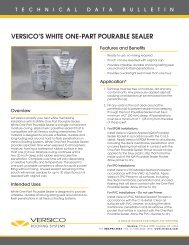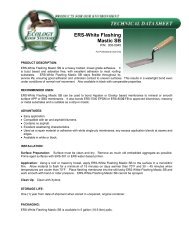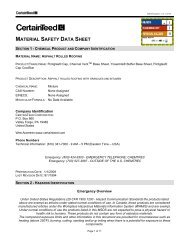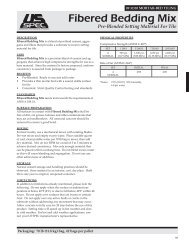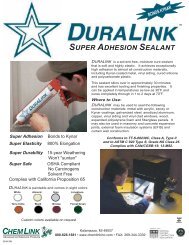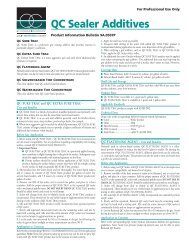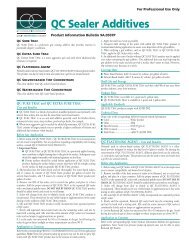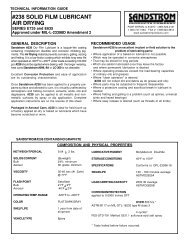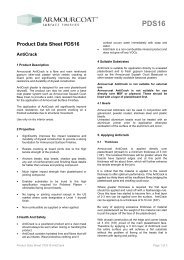Simpson Anchors - Anchoring and Fastening Systems - BuildSite.com
Simpson Anchors - Anchoring and Fastening Systems - BuildSite.com
Simpson Anchors - Anchoring and Fastening Systems - BuildSite.com
Create successful ePaper yourself
Turn your PDF publications into a flip-book with our unique Google optimized e-Paper software.
10<br />
<strong>Anchoring</strong> <strong>and</strong> <strong>Fastening</strong> <strong>Systems</strong> for Concrete <strong>and</strong> Masonry Addendum<br />
AT-XP High-Strength Acrylic-Tie ® <strong>Anchoring</strong> Adhesive<br />
AT-Xp Adhesive Anchor Installation Information <strong>and</strong> Additional Data for Threaded Rod <strong>and</strong> Rebar in Normal-Weight Concrete 1<br />
Characteristic Symbol Units<br />
1. The information presented in this table is to be used in conjunction with the design<br />
criteria of ICC-ES AC308. See pages 18-19 of the <strong>Anchoring</strong> <strong>and</strong> <strong>Fastening</strong> <strong>Systems</strong> for<br />
Concrete <strong>and</strong> Masonry catalog.<br />
1. The information presented in this table is to be used in conjunction with the design<br />
criteria of ICC-ES AC308, except as modiied below. See pages 18-19 of the <strong>Anchoring</strong><br />
<strong>and</strong> <strong>Fastening</strong> <strong>Systems</strong> for Concrete <strong>and</strong> Masonry catalog.<br />
2. Temperature Range 1: Maximum short-term temperature of 110°F. Maximum long-term<br />
temperature of 75°F.<br />
3. Temperature Range 2: Maximum short-term temperature of 180°F. Maximum long-term<br />
temperature of 110°F.<br />
4. Short-term concrete temperatures are those that occur over short intervals (diurnal cycling).<br />
5. Long-term concrete temperatures are constant temperatures over a signiicant time period.<br />
6. For anchors that only resist wind loads, bond strengths may be increased by 11%.<br />
7. In water-saturated concrete, multiply τk,uncr by K sat.<br />
8. For anchors installed in overhead <strong>and</strong> subjected to tension resulting from sustained<br />
loading, multiply the value calculated for Na according to ICC-ES AC308 by 0.75. See<br />
pages 18-19 of the <strong>Anchoring</strong> <strong>and</strong> <strong>Fastening</strong> <strong>Systems</strong> for Concrete <strong>and</strong> Masonry catalog.<br />
Nominal Anchor Diameter (in.) / Rebar Size<br />
3 ⁄8 / #3 1 ⁄2 / #4 5 ⁄8 / #5 3 ⁄4 / #6 7 ⁄8 / #7 1 / #8 1 1 ⁄4 / #10<br />
Installation Information<br />
Drill Bit Diameter d hole in. 7 ⁄ / 1 ⁄2 ⁄ / 5 ⁄8 ⁄ / 3 ⁄4 ⁄1 / 7 ⁄8 1 1 1 ⁄8 1 3 ⁄8<br />
Maximum Tightening Torque T inst ft-lb 10 20 30 45 60 80 125<br />
Permitted Embedment Depth Range 2 Minimum h ef in. 2 ⁄ 2 ⁄4 3 ⁄ 3 ⁄ 3 ⁄4 4 5<br />
Maximum h ef in. 7 ⁄ 10 12 ⁄ 15 17 ⁄ 20 25<br />
Minimum Concrete Thickness h min in. h ef + 5d o<br />
Critical Edge Distance c ac in. 3 x h ef<br />
Minimum Edge Distance c min in. 1 ⁄4 2 ⁄4<br />
Minimum Anchor Spacing s min in. 3 6<br />
AT-Xp Adhesive Anchor Tension Design Data for Threaded Rod <strong>and</strong> Rebar in Normal-Weight Concrete 1,12<br />
2. Minimum <strong>and</strong> maximum embedment depths are set so as to it the ICC-ES AC308 design model.<br />
Characteristic Symbol Units<br />
3<br />
⁄8 / #3<br />
Nominal Anchor Diameter (in.) / Rebar Size<br />
1 5 3 7<br />
⁄2 / #4 ⁄8 / #5 ⁄4 / #6 ⁄8 / #7 1 / #8 1 1 ⁄4 / #10<br />
Steel Strength in Tension<br />
Minimum Tensile Stress Area Ase in<br />
Threaded<br />
Rod<br />
2 0.078 0.142 0.226 0.334 0.462 0.606 0.969<br />
Tension Resistance of Steel - ASTM A307, Grade C<br />
4,525 8,235 13,110 19,370 26,795 35,150 56,200<br />
- ASTM A193, Grade B7<br />
- Type 410 Stainless (ASTM A193, Grade B6)<br />
Nsa lb.<br />
9,750<br />
8,580<br />
17,750<br />
15,620<br />
28,250<br />
24,860<br />
41,750<br />
36,740<br />
57,750<br />
50,820<br />
75,750<br />
66,660<br />
121,125<br />
106,590<br />
- Type 304 <strong>and</strong> 316 Stainless (ASTM A193, Grade B8 & B8M) 4,445 8,095 12,880 19,040 26,335 34,540 55,235<br />
Strength Reduction Factor - Steel Failure ϕ — 0.75 9<br />
Minimum Tensile Stress Area Ase in<br />
Rebar<br />
2 0.11 0.20 0.31 0.44 0.60 0.79 1.23<br />
Tension Resistance of Steel - Rebar (ASTM A615 Grade 60) Nsa lb. 9,900 18,000 27,900 39,600 54,000 71,100 110,700<br />
Strength Reduction Factor - Steel Failure ϕ — 0.75 9<br />
Concrete Breakout Strength in Tension (2,500 psi ≤ f’c ≤ 8,000 psi)<br />
Effectiveness Factor - Uncracked Concrete kuncr — 24<br />
Strength Reduction Factor - Breakout Failure ϕ — 0.65 11<br />
Temperature<br />
Range 1 2,4,5<br />
Bond Strength in Tension (2,500 psi ≤ f’c ≤ 8,000 psi)<br />
Characteristic Bond Strength 8 τ k,uncr psi 1,460 1,460 1,460 1,315 1,240 1,170 1,095<br />
Permitted Embedment Depth Range<br />
*See page 5 for an explanation<br />
of the load table icons<br />
Minimum<br />
2 ⁄ 2 ⁄4 3 ⁄ 3 ⁄ 3 ⁄4 4 5<br />
hef in.<br />
Maximum 7 ⁄ 10 12 ⁄ 15 17 ⁄ 20 25<br />
Characteristic Bond Strength 6,8 τ k,uncr psi 1,315 1,315 1,315 1,185 1,120 1,050 985<br />
Temperature<br />
Range 2 3,4,5<br />
Permitted Embedment Depth Range<br />
Minimum<br />
Maximum<br />
hef in.<br />
2 ⁄<br />
7 ⁄<br />
2 ⁄<br />
10<br />
3 ⁄<br />
12 ⁄<br />
3 ⁄<br />
15<br />
3 ⁄<br />
17 ⁄<br />
4<br />
20<br />
5<br />
25<br />
Bond Strength in Tension - Bond Strength Reduction Factors for periodic Special Inspection<br />
Strength Reduction Factor - Dry Concrete ϕdry — 0.65 10<br />
Strength Reduction Factor - Water-saturated Concrete ϕsat — 0.45 10<br />
Additional Factor for Water-saturated Concrete Ksat — 0.98 7<br />
9. The value of ϕ applies when the load <strong>com</strong>binations of ACI 318 Section 9.2 are used. If the<br />
load <strong>com</strong>binations of ACI 318 Appendix C are used, refer to Section D.4.5 to determine<br />
the appropriate value of ϕ.<br />
10. The value of ϕ applies when both the load <strong>com</strong>binations of ACI 318 Section 9.2 are<br />
used <strong>and</strong> the requirements of Section D.4.4(c) for Condition B are met. If the load<br />
<strong>com</strong>binations of ACI 318 Appendix C are used, refer to Section D.4.5 to determine the<br />
appropriate value of ϕ.<br />
11. The value of ϕ applies when both the load <strong>com</strong>binations of ACI 318 Section 9.2 are<br />
used <strong>and</strong> the requirements of Section D.4.4(c) for Condition B are met. If the load<br />
<strong>com</strong>binations of ACI 318 Section 9.2 are used <strong>and</strong> the requirements of Section D.4.4(c)<br />
for Condition A are met, refer to Section D.4.4 to determine the appropriate value of<br />
ϕ. If the load <strong>com</strong>binations of ACI 318 Appendix C are used, refer to Section D.4.5 to<br />
determine the appropriate value of ϕ.<br />
12. S<strong>and</strong>-lightweight <strong>and</strong> all-lightweight concrete are beyond the scope of this table.<br />
*<br />
F-SAS-CSAS2009 ©2011 <strong>Simpson</strong> Strong-Tie Company Inc.



